Rhubarb (Rheum emodi)
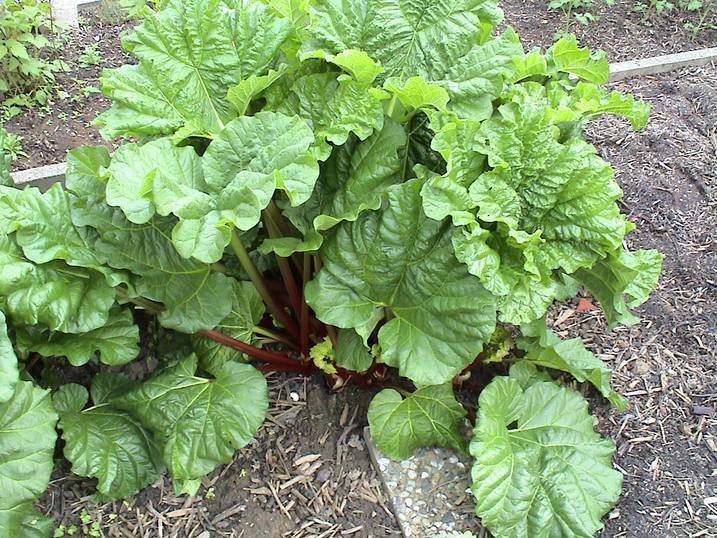
Pita mula- Rheum emodi is an ayurvedic herb mentioned for the treatment of low digestion, constipation, dysmenorrhea, jaundice etc. It is also known as Rhubarb or Revand chini.
Latin name- Rhum emodi Wall.
Family- Polygonaceae
Names in different languages:
English name: Indian rhubarb or Himalayan rhubarb
Hindi name: Dolu, Revandchini.
Afghanistani name – chukri, Rawash
Arabic name – Revanch chini, Rawind
Bengali name – Revandchini
Bombay name – Ladakirevand chini
Canarese name – Naturevalchini
Deccan name – Nahirevandchina
French name : Hubarb de parse
Gujarathi name: Revandchini, Gamni,
Gujarathi :revandchini.
Himachal Pradesh : Ladu, chuchi.
Kamaun: Archu
Kannada name: Revalchini
Ladak : Lachu
Marathi name : Mulkarcvand chini, Revanchini.
Nepalese name: Padamachal
Persian name : Bikrewas, Revandchini.
Punjab : Atsu , Chotial, Chuchi, Pambash, Chutial, Khabium, Lachu, Rewand chini.
Spiti : Lachu.
Tamil name : Variyattu, Natturevandchini
Telugu : Nattupampuch, Nattureval chini
Urdu : Rewand chini
Sanskrit synonyms:
Amlaparni- The leaves are sour in taste
Pitamulika- The roots are yellow in color
Grandhika, Gandhini- The plant has a dominant odor
Swedachini, Revadhika, Hrithdhatri, Kankushta
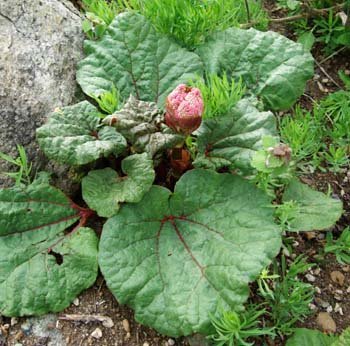
Morphology of Rheum emodi:
Rhubarb is a stout herb 1.5 – 3.0 m in height, distributed in the Himalayas from Kashmir to Sikkim at altitude of 3,300 m to 5,200 m. It is also cultivated in Assam for its leaves consumed as vegetable. The stem is hard, green with brownish streaks. The flowers are 2-3 foot long and purple to reddish colored seen in the month of July to August. The fruits are about 1-2 cm long, purple colored and seen in the month of September to October. The root of the plant is thick, strong and yellow in color. The roots are dried and sold. There are three main types of rhubarbs—Chinese, Indian or Himalayan, and Rhapontic.
Revandchini – medicinal properties:
Rasa (Taste) – Katu (Pungent), Tikta (Bitter)
Guna (Qualities) – Laghu (Light for digestion), Ruksha (Dry in nature), Teekshna (Strong)
Vipaka – Katu (Undergoes Pungent taste after digestion)
Veerya (Potency) – Ushna (Hot)
Karma (Actions) – Kaphapiyta shamaka (reduces vitiated kapha and pitta dosha)
Part used- Underground stem, Root
Dosage- 0.2 g to 1 g
Chemical composition of Rheum emodi:
The root gave emodin, emodin-monomethyl ether, chrysophanol, aloemodin, rhein. These occur free and as quinone, anthrone or dianthroneglycosides. The astringent principle consists of gallic acid together with small amounts of tannin. The drug also contain cinnamic and rheinolic acids, volatile oil, starch and calcium oxalate. Two major glycosidic active principles, sennoside A and B, are present along with free anthraquinones. Rhubarb also contains rhein acids and calcium oxalate. Rhubarb yields to alcohol about 40 % of extractives.
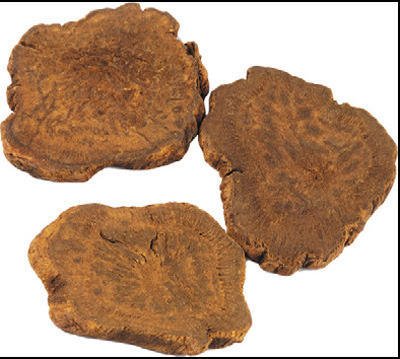
Habitat:
Himalayas from Kashmir to Sikkim
Assam
Cultivated in China, Tibet, India, Germany and other European countries.
गन्धिनी पीतमूली च बल्या सा मृदुरेचनी ।
हन्त्यजीर्णमतिसारं वह्रिमान्ह्यमरोचकम् ॥ Ayurveda Vijnana
Uses of Pitamuli:
- The powdered root of Indian Rhubarb is sprinkled over wound for wound healing.
- The leaf stalk is used as fresh salad and vegetable.
- The powder of the stem and root is used in a dose of 0.5 g with hot water to relieve constipation.
- Cold infusion of the leaf of Pitamuli is given in a dose of 25 ml to treat dysmenorrhea and retention of urine.
- The powder of the root is used as dental powder for cleaning the teeth and treating gingivitis.
- The powder of the root of Rheum emodi is given in a dose of 1 g to treat hepatomegaly and jaundice.
- The fresh leaf of the plant improves the appetite and increases the digestive capacity and hence can be used as raw salad.
- The powder of the root of Pitamuli is given in a dose of 0.5 g with honey to treat cough and rhinitis.
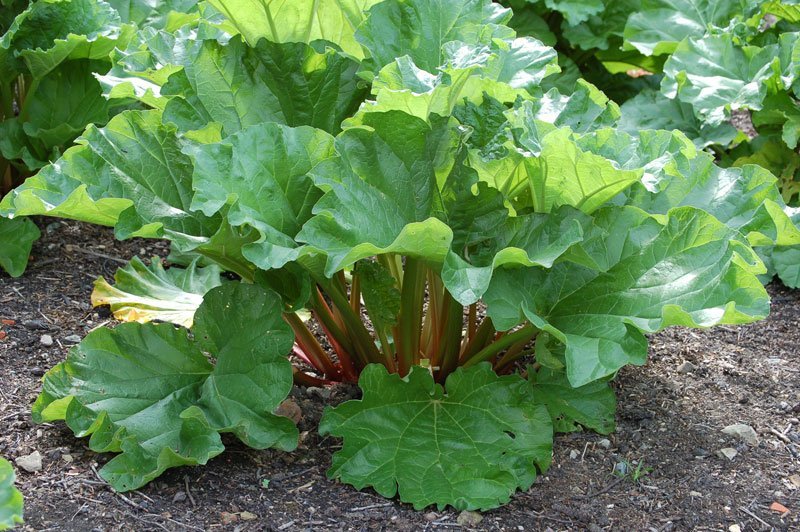
Adverse effects: Excessive use of the roots of Pitamuli can cause increased peristaltic movement leading to diarrhea and cramps. Hence care should be taken during its use.
Ayurvedic medicines with Rubarb as ingredient:
Chiniumco tablet: This is a proprietary Ayurvedic medicine used in the treatment of profuse bleeding from nose, intestine, piles, uterus etc.
Arjin tablet: This is a proprietary Ayurvedic medicine used in the management of hypertension.
Bleminor cream: It is a proprietary Ayurvedic medicine. Bleminor’s anti-inflammatory property is beneficial in preventing hyper-pigmentation due to recurrent inflammation. It also aids in correcting skin discoloration resulting from injury.
Kankayanvati: This is a medicine in tablet form useful to treat intestinal worms, piles, bloating of the abdomen.
Panchamla taila: Panchamla Thailam is an Ayurvedic oil used externally for the treatment of ascites, rheumatoid arthritis and joint pain.
Research articles related to Rheum emodi:
Anti- oxidant activity: This study aims to investigate antioxidant power of stilbenoids from R. emodi and then explore the material basis for its antioxidant potential. The most abundant stilbenoid piceatannol-4′-O-β-D-glucopyranoside (PICG) and its aglycon piceatannol (PICE) were isolated from R. emodi rhizome. Taking into account the rapid in vivo metabolic transformation of PICG into PICE it can be inferred that the most abundant stilbenoid PICG may be an important constituent responsible for the antioxidant potential of R. emodi and promising to be developed as an antioxidant agent for supplementary or therapeutic use.
Anti- microbial activity: Powders of S. mukorossi and R. emodi were extracted successively with petroleum ether, benzene, chloroform and ethanol and were concentrated in vacuum. It was found that ethanol and chloroform extracts of S. mukorossi and ethanol and benzene extracts of R. emodi inhibited H pylori at very low concentrations. In the in vitro study, the isolates showed a considerable zone of inhibition at very low concentrations (10 μg/mL) for both the extracts. In the in vivo study, the H pylori infection was cleared with minimal doses of extracts of S. mukorossi (2.5 mg/mL) and R. emodi (3.0 mg/mL) given orally for seven days.
Anti- fungal activity: Podophyllum hexandrum and Rheum emodi were investigated for their antimicrobial properties against pure cultures of clinical isolates of Aspergillus niger ATCC 1197 and Candida albicans ATCC 10231. The results of the antimicrobial assay of the methanolic extracts of both the plant extracts indicated that the plants exhibited antimicrobial activity against the tested microorganisms at four different concentrations of 25mg/ml, 50mg/ml, 75mg/ml and 100mg/ml.
Hepato -protective action: The protective potential of the total Anthraquinone glycoside fraction of Rheum emodi was determined by evaluating Aminotransferase activity, mitochondrial membrane potential, calcium-induced liver MPT (Mitochondrial permeability transition) and VDAC expression. Pretreatment with a total Anthraquinone glycoside fraction of Rheum emodi showed significant preservation of mitochondrial membrane potential as compared to CCl4 control demonstrating the mitochondrial protection. In addition, pretreatment with TAGF Rheum emodi at various concentrations exerted a dose-dependent effect against sensitivity to mitochondrial swelling induced by calcium.
Rheum palmatum
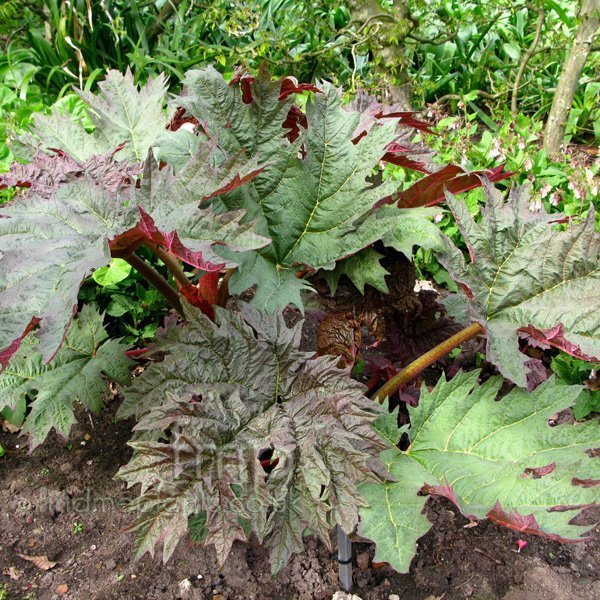
Classical categorization:
Bhavaprakasha- Dhatwadi varga
Nighantu Adarsha- Nagapushpadi varga
Scientific classification
Kingdom: Plantae
Order: Caryophyllales
Family: Polygonaceae
Genus: Rheum
Species: R. emodi
Common Adulterants:
Rheum Webbianum Royle.
Rheum Moorcroftianum Royle.
Rheum Spiciforma Royle.
Rheum Nobile Hook.